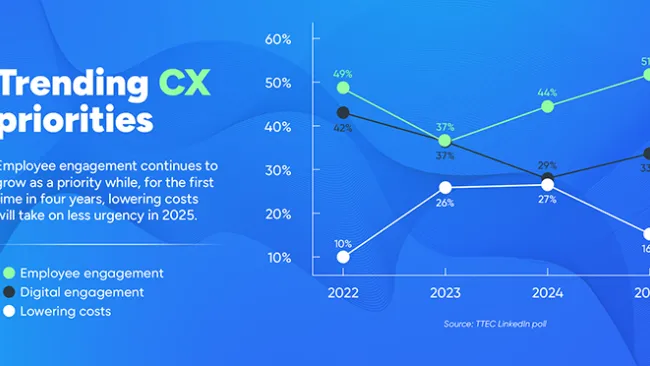New technologies combine with traditional contact centers to manage the three crises government agencies must face: COVID-19, record-breaking unemployment filings, and confusion around the CARES Act
For state and local government agencies, flattening the curve is only one of many crises they face. The full and exigent nature of their responsibilities extends beyond slowing the spread of infection. At a time when agencies are already struggling to meet routine needs, agencies must now also face surging call volumes as financially strapped citizens search for answers about unemployment and rapidly changing government mandates. Acknowledging the challenges that agencies are facing, the CARES Act has provided funding for technology improvements to better manage the surge in citizen outreach. But agencies still need clarity on how to best leverage these funds to make the most positive impact on the public.
Before we begin to solve these challenges, it is important to understand the needs of the people who are calling agencies, many of whom have never filed for unemployment and nearly all of whom have never confronted as large of a threat to their security and welfare as the threat of COVID-19. “Lack of predictability and control are the two major elements underlying the cognitive appraisal of stress ,” write T.J. Shors and B. Horvath in the International Encyclopedia of Behavioral Sciences. It is often what compels citizens to overwhelm government contact centers in an attempt to regain normalcy.
For government agencies to effectively combat the multitude of crises they are facing, they must first give the public a sense of control by responding quickly to their needs, and a sense of predictability by delivering consistent and proactive support. Modern contact centers with their ability to both deliver support and proactive outreach, can be essential partners to government agencies who are trying to get ahead and restore stability.
Modernizing the Traditional Contact Center
Too few operators, outdated technology, and inadequate training were common for state and local agencies before the global pandemic. With COVID-19, they are now faced with surging call volumes coupled with reduced capacity as unequipped and unprepared staff go to work from home. Frantic calls go unanswered as public unrest becomes more apparent.
To respond quickly, government agencies need to immediately expand their contact center resources, increase productivity with modern technology, and deliver rapid training to ensure proper resolution to issues. The question is how?
ENABLING A VIRTUAL WORKFORCE
Contact center employees no longer need to be physically located in bricks-and-mortar contact centers to answer citizen calls. They can be recruited, rapidly trained, and equipped to work from home with state-of-the-art technology. Not only do these solutions immediately add remote-based associates to contact centers with the flexibility to handle call volume surges, but they can also provide much-needed jobs to states impacted by stay-at-home measures needed to flatten the curve.
DIVERSIFYING CONTACT CHANNELS
In the private sector, customers no longer seek support merely using voice channels. Customers find support via in-app chat, SMS, web-based chat, and social media. This “omnichannel” strategy serves three purposes. First, it enables customer support associates to quadruple the productivity of the number of customers that associates manage concurrently. Second, it eliminates many disadvantages of work-from-home environments, such as background noise and high-bandwidth requirements. Finally, it improves customer satisfaction. Applied to government agencies, diversifying contact channels enables an agency to handle more calls with fewer resources and increased satisfaction.
ENABLE INTELLIGENT AUTOMATION
Many interactions can be automated using intelligent virtual assistants (IVAs), robotic desktop automation (RDA), and robotic process automation (RPA).
One example of how intelligent automation accelerates citizen outreach is in the training of new agents. With artificial intelligence (AI) powered training, an AI takes the role of a customer in need, simulating the types of scenarios a government contact center associate will face. The system records the associate’s responses to the AI, analyzes how effective the associate is in solving the problem, and provides real-time feedback and coaching.
Intelligent automation also can accelerate ramp-up time for a new contact center by serving as an IVA to new associates. IVAs are AIs that listen in to interactions, analyze sentiment and intent, and dynamically deliver recommended answers and supporting knowledge articles to associates in real time using RDA and RPA.
Proactive Outreach
Modern contact centers can do more than just wait for calls to come in. They can be used to connect to citizens to reduce confusion, and thereby reduce call volumes. Messaging, in particular, delivers infinite scalability at low cost, especially when combined with chatbots, who nudge citizens to comply with specific guidance. In Anchorage Alaska, for instance, residents can access public benefits by texting “SNAP” to a designated number, rather than facing traditional bureaucratic hurdles. New Orleans also uses text messages to encourage citizens to access free medical care. A free push SMS notification app was offered by Citibot to provide citizens with information related to COVID-19 and a channel for citizens to respond.
The need for proactive messaging will be necessary for states who are experiencing high unemployment like Michigan, Hawaii, and Rhode Island. These states already have over 1/3 of their population laid off, a level of unemployment not seen since the Great Depression.
With proactive outreach, government agencies can proactively communicate eligibility requirements for public assistance programs, direct applicants to appropriate forms, and deliver information on where to get tested for COVID-19 or seek free medical care if needed. Not only do citizens feel more in control when given the tools to manage their circumstances, it also reduces the call volumes that threatens to overwhelm government agencies today.
Leverage Contact Center Innovation
Contact centers can be more than just complaint collectors, and instead can be used to flatten the curve. Virtual, omnichannel contact centers can be stood up in days and leveraged to handle non-traditional contact center tasks, such as contact tracing.
CONTACT TRACING
The Director of the CDC has stated that “very aggressive contact tracing is needed” for the U.S. to return to normalcy. Public health workers use contact tracing to identify positive cases of COVID-19 and alert others who may have been exposed so they can monitor and/or quarantine themselves until transmission of the illness is halted. Traditional contact centers combined with mobile contact tracing apps can rapidly assist public health workers to identify cases and prevent further infections from overwhelming health systems. A guide on how to establish a contact tracing program can be downloaded here.
SUPPORTING LOCAL ECONOMIES
Most public outreach is a one-way conversation. But what if government agencies could encourage local commerce while supporting citizens in need? Messaging affords government agencies the opportunity to surprise and delight with thoughtful outreach to celebrate moments that matter like successfully completing quarantine or no longer needing public assistance. With an automated chatbot, coupons and discounts supporting local businesses can be delivered if an applicant answers they are no longer unemployed or sick, connecting communities and making them stronger.
Be Ahead of More Than One Curve
Ultimately, the challenge that lays ahead for government agencies is not to flatten one, but several curves to restore stability to the citizenry. COVID-19 may have originated the crisis, but unemployment and confusion about the CARES Act deliver anxieties that government agencies must find ways to manage, or risk being overwhelmed and prolong the crises even further. Thankfully, contact centers can be the partner that government agencies need in this critical moment, and deliver the predictability and control citizens need to survive and thrive in the years ahead.















